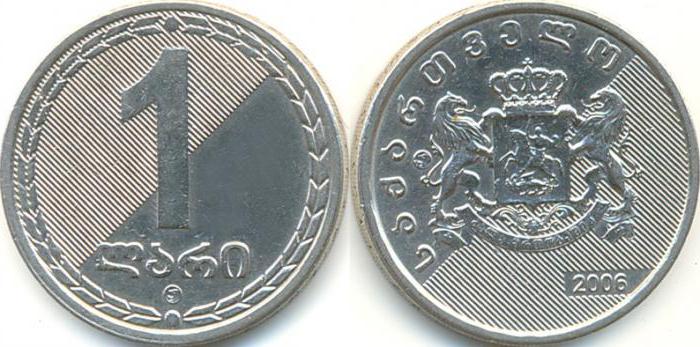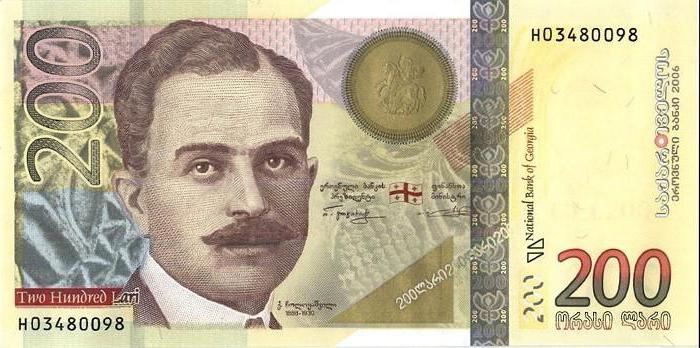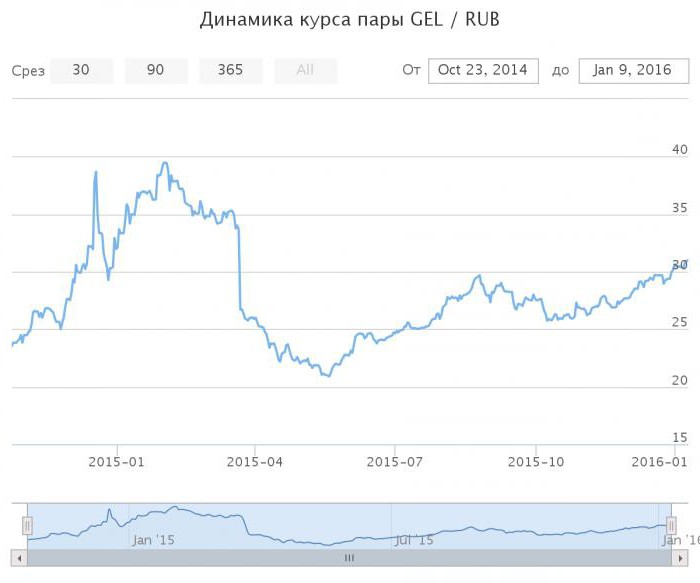The only monetary unit used in internal and, in part, in external payments, Georgia is the Georgian lari. The name of the currency comes from the Georgian word, which means "property" or "stock" in translation into Russian.
Characteristics of the national currency of Georgia
To date, two issues of money are in circulation on the territory of Georgia. The first dates back to 1999, the second to 2006. Banknotes and coins of both series have the same form and attributes of authenticity. Also in circulation there is a special series issued for the anniversary of the national currency of Georgia, coins in denominations of 10 lari.
Coins were issued at the request of the Central Bank of Georgia at the Paris Mint and partially at the mints of Slovakia and Bratislava.
As well as other currencies of the world, the Georgian lari is divided into a unit of smaller face value - tetri. One lari is equal to one hundred tetri.

History of Georgian Currency
Earlier, before the collapse of the USSR and the detachment of Georgia, the banknotes of the USSR — Soviet rubles — were used in the calculations, then they were temporarily replaced by Georgian coupons. However, the use of coupons in Georgia lasted only 4 years - in 1995, by the decree of President Shevardnadze, the lari was put into circulation.
The Central Bank assigned the development of banknote design to European designers, in particular, French and Slovak masters made their contribution. The Georgian currency contains images of cultural figures and national heroes, and on the reverse, the back of banknotes and coins, there are images of architectural and art monuments belonging to Georgia.
Coins from the jubilee issue were given special attention: a thoughtful pedantic design, coupled with the use of a bimetallic manufacturing method, allowed to obtain several colors: silver, copper and golden.

Rating and appearance of the currency of Georgia
The currency of Georgia has a wide rating, 8 notes of various denominations, 7 coins of standard issue and 5 coins of jubilee are used in circulation.
Banknotes of Georgia have a very convenient nominal division and contain images of important people and cultural monuments of the state:
- 1 GEL. On the front side is the artist Niko Pirosmani, on the back - the landscape of Tbilisi.
- 2 GEL. On the front side is the composer Zakhary Pashiashvili, on the back - the building of the Grzinsky Opera and Ballet Theater named after the same composer.
- 5 GEL. Academician Ivane Javakhishvili is on the front side, and Tbilisi State University named after him is on the reverse.
- 10 GEL. On the front side is a public figure Akaki Tsereteli, on the back there is a fragment of David Kakabadze’s painting “Imeretia is My Mother”.
- 20 GEL. On the obverse is a public figure Ilya Chavchavadze, on the reverse there is a monument to Tsar Vakhtang I Gorgasal against a map of 18th-century Tbilisi.
- 50 GEL. On the front side is Queen Tamara and the image of a griffin from the Samtavisi temple, on the back - “Sagittarius” from the 12th century Georgian engraving.
- 100 GEL. On the front side is a portrait of the poet Shota Rustaveli, on the back there is a graphic depiction of the biblical plot from the monastery in Martvili.
- 200 bai. On the front side is the national hero of Georgia Kaihosro Cholokashvili, on the back - a view of Sukhumi from an old engraving.

The currency of Georgia has a wide nominal differentiation, which greatly simplifies the settlement, and also allows citizens to flexibly operate personal finances.
Monetary Policy of Georgia
Today, the management of the monetary policy of Georgia is fully entrusted to the Central Bank of Georgia, the activities of which are regulated by state laws, while, according to Article 95 of the Constitution of Georgia, the Central Bank operates independently of executive authorities.
The national currency of Georgia is one of the central objects of regulation of the Central Bank of Georgia. The following goals and objectives facing him:
- Maintaining a fair market rate for the national currency.
- Maintaining inflation target.
- Maintaining price stability.
- Ensuring the efficient use and accumulation of foreign exchange reserves.
- Supervision of the banking sector and other financial institutions on issues of circulation and exchange of national currency.
- Currency authentication in circulation.
Georgian lari to the ruble and other currencies
The basis for the formation of the GEL exchange rate in relation to other foreign currencies is the action of market forces - demand, supply and price. In December 2015, the Central Bank of Georgia canceled the binding of the currency to the dollar. By international standards, GEL has the abbreviation GEL.
The fundamental criterion that determines the market parity of lari is the price of oil, due to the fact that Georgia is one of the oil exporting states. There is a stable inverse correlation between the price of oil and the rate of the lari.
At the end of 2015 and the beginning of 2016, the GEL rate against a basket of major world currencies was as follows:
- USD / GEL 0.414.
- EUR / GEL 0.379.
- GBP / GEL 0.285.
- CAD / GEL 0.587.
- AUD / GEL 0.590.
- NZD / GEL 0.633.
- RUR / GEL 0.032.

Recently, the lari has noticeably weakened amid falling oil prices, it remains at risk, therefore, in the period 2016-2017. a number of foreign exchange interventions by the Central Bank of Georgia is possible in order to keep the exchange rate from falling deeply.

